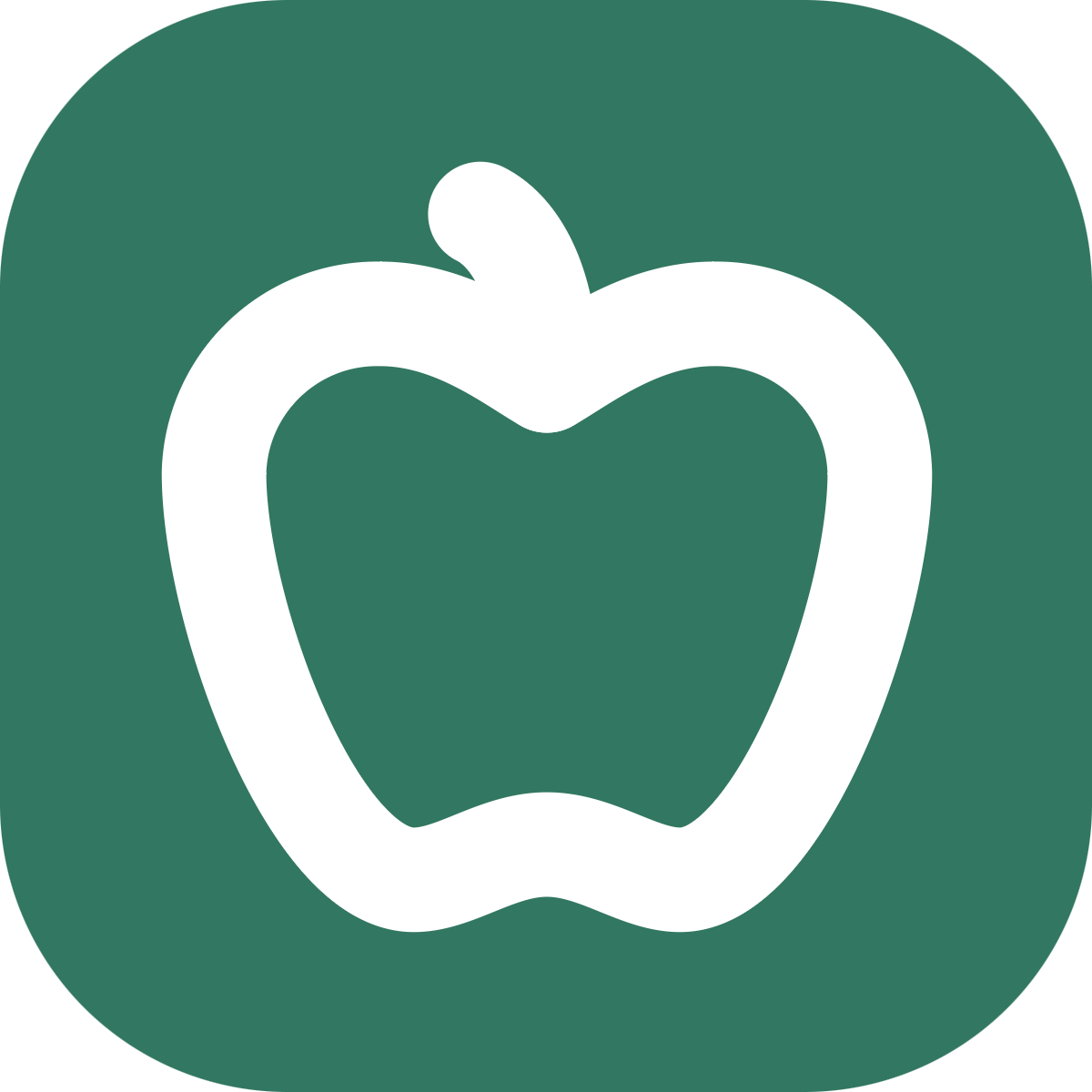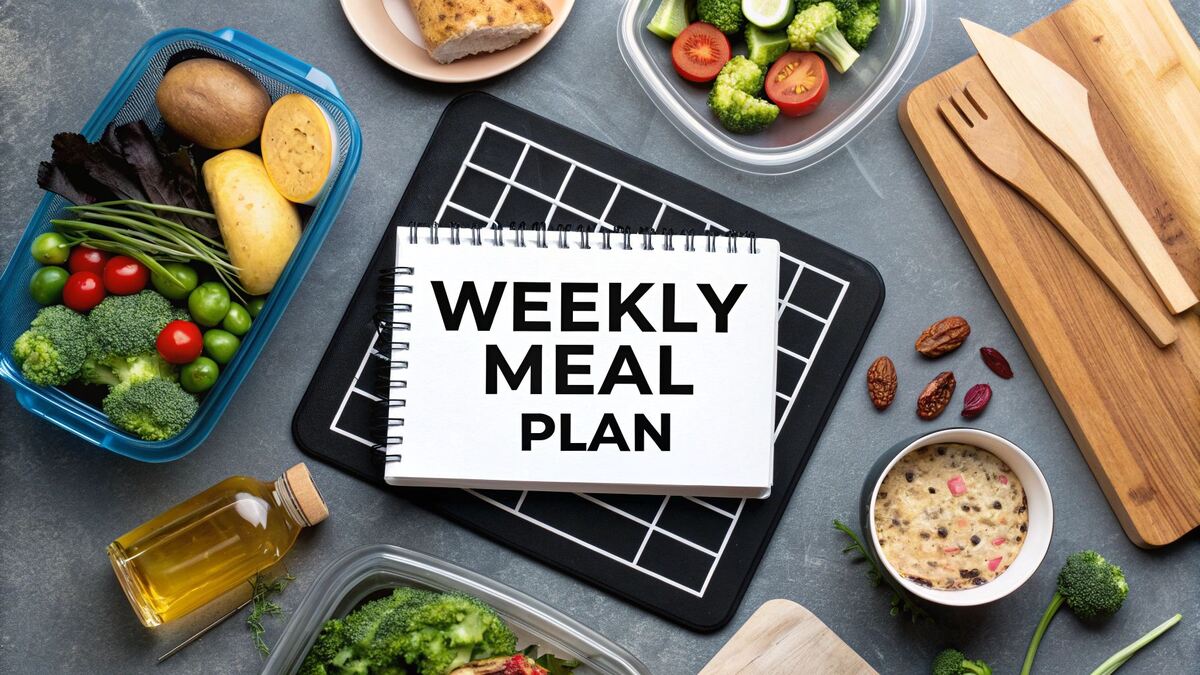Your Weekly Meal Plan for Healthy Eating
A successful meal plan doesn't start with recipes. It starts with you. Before you even think about what you're going to eat, you need to get clear on your personal health goals and what your body actually needs. This is the foundation, and if you get it right, you're building a plan that's not just sustainable but genuinely enjoyable.
Building Your Healthy Eating Foundation
Jumping into a generic seven-day menu you found online is like starting a road trip without a destination. Sure, you're moving, but you're not really going anywhere. The real magic of a weekly meal plan happens in the prep work—this is where you create a blueprint that feels less like a chore and more like a natural part of your life.
And it seems more people are catching on. The global meal planner market was valued at USD 12 billion in 2024 and is expected to more than double to USD 28 billion by 2032. That’s a huge jump, and it’s driven by a growing understanding of just how important nutrition is, especially when our lives are so busy. If you’re curious about the numbers, you can dig into market trends from Business Research Insights.
Define Your Personal Health Goals
First things first, ask yourself: what’s my ‘why’? This motivation is what will keep you going when life gets in the way. Are you trying to manage your weight, feel more energized, or fuel a new fitness habit? A vague goal like "eat healthier" is tough to stick with because you can't measure it.
Get specific. Pinpoint exactly what you're aiming for.
- For Weight Management: Maybe your goal is, "I want to create a 500-calorie deficit each day to lose about one pound a week."
- For More Energy: It could be, "I'm going to include lean protein and complex carbs in every meal to beat that afternoon slump."
- For Fitness Support: You might decide, "I need to hit 120 grams of protein daily to help my muscles recover after workouts."
When you have clear, measurable targets, your meal plan has a real purpose. That makes it so much easier to stay on track.
"A goal without a plan is just a wish. Defining your objectives transforms your desire for healthy eating into an actionable strategy."
Understand Your Basic Nutritional Needs
You don't need a Ph.D. in nutrition to eat well. A great starting point is simply aiming for a balance of macronutrients—that’s your proteins, carbohydrates, and fats. I often recommend the "plate method" because it's so simple and visual.
For most of your meals, just imagine your plate is divided up like this:
- 50% Non-Starchy Veggies: Fill half your plate with things like broccoli, spinach, bell peppers, and cauliflower. They're loaded with vitamins and fiber.
- 25% Lean Protein: Dedicate a quarter to chicken breast, fish, beans, lentils, or tofu. Protein is key for muscle repair and it keeps you feeling full.
- 25% Complex Carbs: The last quarter is for whole grains like quinoa, brown rice, or sweet potatoes. These give you slow-release, sustained energy.
This simple guide helps you build balanced meals without obsessing over calorie counting right away. To really build a robust foundation for healthy eating, it's worth taking the time to explore the benefits of adopting a whole diet approach.
Conduct a Quick Pantry and Fridge Audit
Last but not least, take a quick peek at what you already have on hand. This isn't about a deep spring clean. It's just a strategic scan to see what ingredients you can work into the week's plan. You'd be surprised how much this little step can cut down on food waste and your grocery bill.
Look for staples you might have forgotten about—canned beans, whole-wheat pasta, rice, that bag of frozen veggies. You might realize you already have the base for a few meals. This quick audit makes your shopping trip smarter and more focused, ensuring you only buy what you truly need. It's the final piece of the puzzle for laying a solid foundation for your week of healthy eating.
Designing a Flexible Seven-Day Meal Template
Now that you've got your health goals pinned down, it's time to build the actual framework for your week of healthy eating. I've seen countless people make the same mistake: creating a plan so rigid it's practically set in stone. But life is messy and unpredictable, and an inflexible schedule is just setting yourself up for failure. The real key is designing a template that works for you, not against you.
This isn't about assigning a specific meal to every single slot. Think of it more like building a meal "toolkit" for the week. You'll have a collection of go-to options that you can pull from based on your schedule, how much energy you have, or even what you're craving.
Structuring Your Daily Meals and Snacks
A great way to start is by creating categories for breakfast, lunch, dinner, and snacks. For each one, just brainstorm a few simple, healthy options you genuinely enjoy eating. This simple act cuts down on decision fatigue in a huge way because you're choosing from a pre-approved list instead of the entire grocery store.
Your template might look something like this:
- Breakfasts (Pick 1 daily): Greek yogurt with berries, oatmeal with nuts, or a two-egg scramble with spinach.
- Lunches (Pick 1 daily): Dinner leftovers (my favorite shortcut!), a big salad with grilled chicken, or a quinoa bowl with roasted veggies.
- Dinners (Make 1-2, always make extra): Salmon with asparagus, lentil soup, or turkey meatballs with zucchini noodles.
- Snacks (Have 1-2 daily): An apple with peanut butter, a handful of almonds, or baby carrots with hummus.
Having a rotation of 3-4 go-to options for each meal gives you plenty of variety without feeling overwhelming.
A Sample 7-Day Balanced Meal Plan Template
To give you a clearer picture, here’s a simple template you can adapt. Think of this as a starting point. Feel free to swap days, mix and match meals, or substitute ingredients based on what you have on hand. The goal here is structure, not a strict set of rules.
| Day | Breakfast | Lunch | Dinner | Snack |
|---|---|---|---|---|
| Monday | Oatmeal with Berries & Walnuts | Leftover Chicken Stir-fry | Lentil Soup with Whole Grain Bread | Greek Yogurt |
| Tuesday | Scrambled Eggs with Spinach | Quinoa Salad with Chickpeas | Baked Salmon with Asparagus | Handful of Almonds |
| Wednesday | Greek Yogurt with Granola | Leftover Lentil Soup | Turkey Meatballs & Zucchini Noodles | Apple with Peanut Butter |
| Thursday | Smoothie with Protein Powder | Leftover Turkey Meatballs | Chicken & Veggie Skewers | Baby Carrots & Hummus |
| Friday | Whole Wheat Toast with Avocado | Salad with Leftover Chicken | Homemade Veggie Pizza on Naan | Dark Chocolate Square |
| Saturday | Pancakes with Fresh Fruit | Leftover Pizza or Sandwich | Tofu Stir-fry with Brown Rice | Rice Cakes with Nut Butter |
| Sunday | Omelet with Vegetables | Leftover Tofu Stir-fry | Meal Prep for the Week | Edamame |
Remember, this is just one example. You can easily tweak it for a low-carb diet by swapping rice for cauliflower rice, or make it plant-based by using beans and tofu as your primary proteins.
Sample Meal Ideas for Different Lifestyles
Flexibility also means tailoring your template to your specific dietary needs. A truly effective meal plan isn't a one-size-fits-all solution. It needs to reflect your personal tastes and health goals, whether you're aiming for a balanced diet, lower carbs, or fully plant-based meals.
This visual breaks down how to put these ideas into practice in a really simple way.
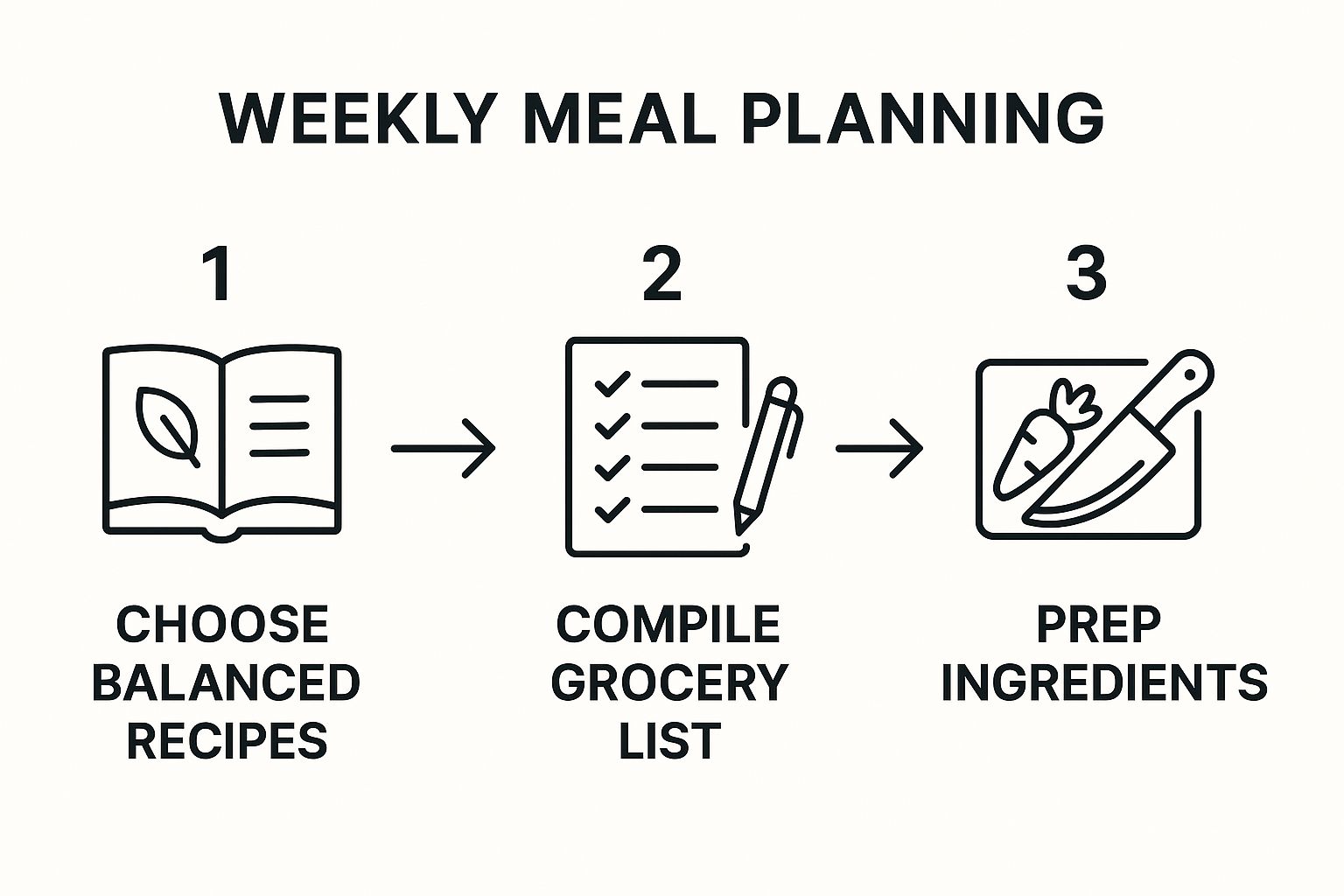
As you can see, a successful week of eating well begins with choosing your recipes before you even think about the grocery list or the chopping block.
Let’s look at how this plays out for different eating styles. A balanced approach might use the plate method we talked about earlier. A low-carb plan would swap out grains for more non-starchy veggies and healthy fats. And a plant-based plan would lean on proteins like tofu, beans, and lentils.
You can really see the power of this mix-and-match approach when you adapt a single dinner idea for three different styles.
| Diet Style | Protein Component | Carb Component | Fat Component |
|---|---|---|---|
| Balanced | Grilled Chicken Breast | Quinoa | Olive Oil Drizzle |
| Low-Carb | Baked Salmon | Cauliflower Rice | Avocado Slices |
| Plant-Based | Baked Tofu | Sweet Potato | Tahini Dressing |
See that? The core structure—protein, carb, fat—is the same, but the ingredients change. This is the secret to building a plan that never gets boring.
Embrace the "Cook Once, Eat Twice" Mindset
One of the most powerful strategies I've learned for sticking to a meal plan is the "cook once, eat twice" philosophy. This simple concept will save you an incredible amount of time and stress during a busy week. Whenever you're cooking dinner, just get in the habit of making extra.
By doubling your dinner recipe, you're not just making another meal; you're creating a 'fast pass' to a healthy lunch the next day, bypassing the temptation of less healthy convenience foods.
And this doesn't mean you're stuck eating the exact same thing two days in a row. Leftovers are incredibly easy to transform.
- Sunday's roasted chicken becomes the filling for Monday's chicken salad sandwich on whole-wheat bread.
- Leftover chili from Tuesday night is perfect served over a baked sweet potato for Wednesday's lunch.
- Extra grilled steak and roasted vegetables from dinner can be tossed into a quick fajita-style bowl with some salsa and Greek yogurt.
This approach ensures a healthy, home-cooked meal is always the easiest option. You're just repurposing components to create something fresh and exciting, which keeps things interesting and your health goals on track. It’s the ultimate shortcut for making a meal plan work in the real world.
Turn Your Grocery Run Into a Smart, Strategic Mission
A brilliant weekly meal plan is only as good as the grocery trip that brings it to life. Think of your shopping list as the blueprint connecting your healthy ambitions to what actually ends up on your plate. Nailing your grocery run is a skill, and it's one that saves you time, money, and a whole lot of last-minute stress.
The mission is simple: get in, get exactly what you need, and get out without succumbing to the temptations lurking in every aisle. A focused, efficient trip to the store is what sets you up for a week of success.
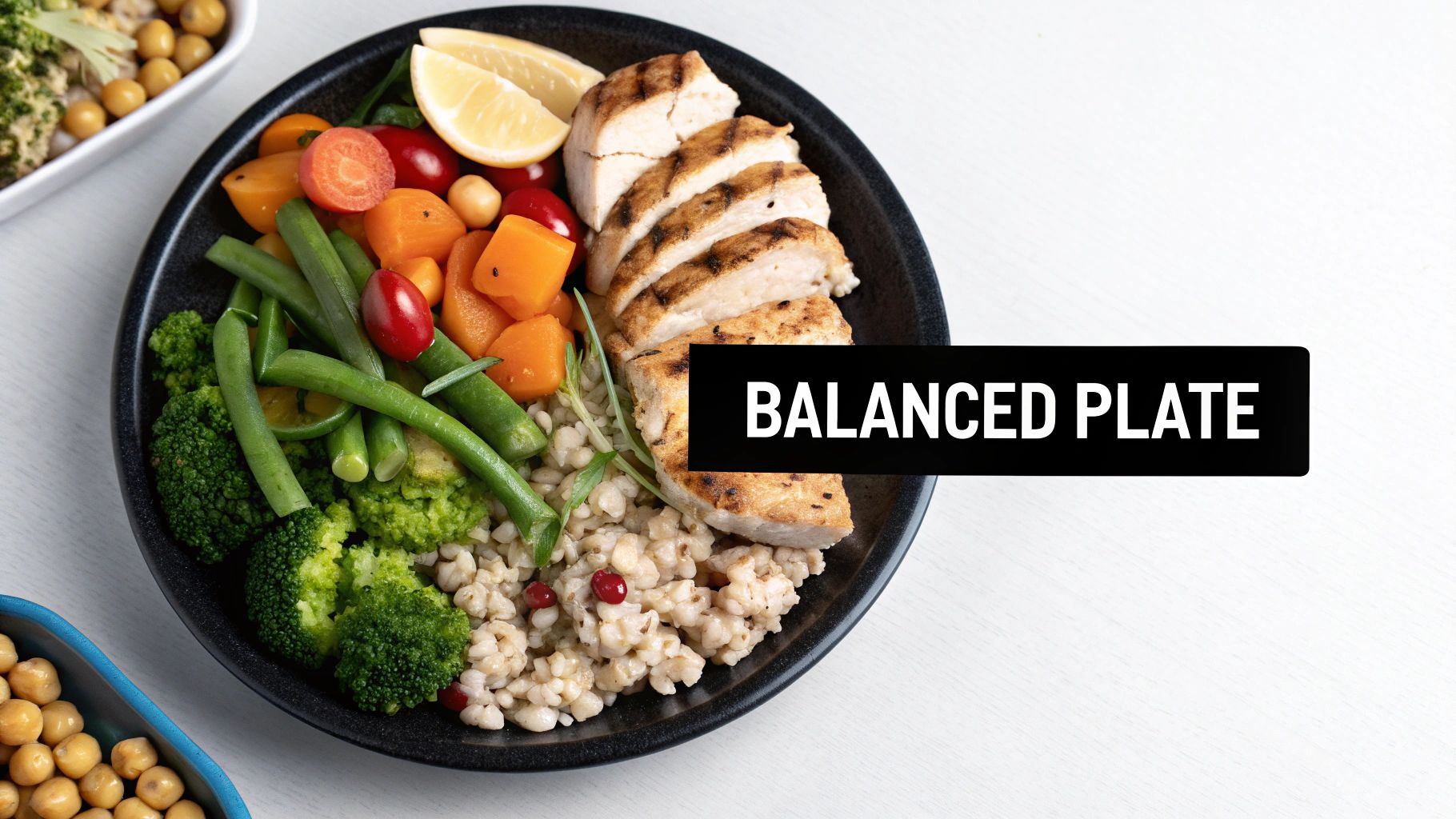
Organize Your List by Store Layout
Have you ever walked into the grocery store with a list, only to spend an hour wandering aimlessly? An unorganized list is an open invitation for impulse buys and wasted time. The fix is surprisingly simple: structure your list to match the layout of the store. This one small tweak transforms a chaotic scavenger hunt into a streamlined mission.
Most grocery stores follow a pretty predictable pattern. By grouping your list items into these common categories, you can move through the aisles logically, hitting each section just once.
- Produce: Fresh fruits and veggies are almost always near the entrance.
- Proteins: This covers the butcher counter, seafood, and the dairy aisle (think eggs and yogurt).
- Pantry Staples: The center aisles are home to grains, canned goods, spices, and oils.
- Frozen Foods: These are typically found along the outer perimeter of the store.
This method does more than just stop you from backtracking for that one forgotten onion. It keeps you focused and makes you far less likely to get sidetracked by the snack aisle when you’re on a mission for produce.
Learn to Decode Nutrition Labels
Getting comfortable with a nutrition label is a game-changer for making healthier choices on the fly. You don't need to dissect every single number, but knowing where to look can help you sidestep marketing fluff and understand what you're actually eating. Always flip the package over to get the real story.
Start by focusing on these key areas:
- Serving Size: Pay close attention here. All the other numbers on the label are based on this amount, and it’s often smaller than what you'd actually eat. A small bag of chips might contain 2-3 servings, which can be incredibly misleading.
- Added Sugars: This is a big one. Your goal should be as close to zero as possible. Sneaky sugars in sauces, dressings, and even "healthy" yogurts can quickly derail your efforts.
- Sodium: Processed foods are notorious for high sodium content. Keeping an eye on this is crucial, especially for things like canned soups, frozen meals, and deli meats.
- Ingredients List: This is the most honest part of the package. Ingredients are listed by weight, so if sugar or words you can't pronounce are at the top, it's a good sign to put it back on the shelf.
A simple rule of thumb? The more you stick to whole foods like fresh produce, the less you have to worry about deciphering confusing labels in the first place.
Shop Seasonally and Explore Your Options
One of the easiest ways to save money and get incredible-tasting food is to shop with the seasons. When fruits and vegetables are in season, they're abundant, which drives prices down. More importantly, they’re at their peak in flavor and nutritional value. Building your weekly meal plan for healthy eating around seasonal produce is a win for both your wallet and your taste buds.
Of course, how we shop has changed dramatically, too. Online grocery services offer an incredibly convenient alternative to the traditional store run. This isn't just a niche trend; it's part of a massive shift toward accessible, healthy eating solutions. Just look at the meal kit delivery market, where the user base exploded from 9.4 million in 2017 to almost 20 million by 2021. You can explore more about these meal kit delivery trends to see how much people crave convenience.
So, how do the two shopping methods stack up?
| Aspect | In-Store Shopping | Online Grocery Services |
|---|---|---|
| Control | You get to hand-pick your produce and check expiration dates yourself. | You have to trust the shopper to choose quality, fresh items for you. |
| Impulse Buys | The risk is much higher. It's easy to grab unplanned items. | It's much easier to stick to your list and avoid temptation. |
| Time | Can be a significant time investment, including travel and checkout. | Saves a huge amount of time and can be done from anywhere. |
| Cost | You can easily compare prices and spot unadvertised deals in the aisles. | May involve delivery fees, tips, or slight markups on certain items. |
Ultimately, the best choice comes down to what you value most. If you love the control of picking your own produce and hunting for bargains, the in-store trip is probably for you. But if your biggest challenges are time and sticking to your list, online shopping could be the perfect solution. The right approach is simply the one that helps you consistently get the food you need for a healthy week.
Making Your Meal Prep Actually Work for You
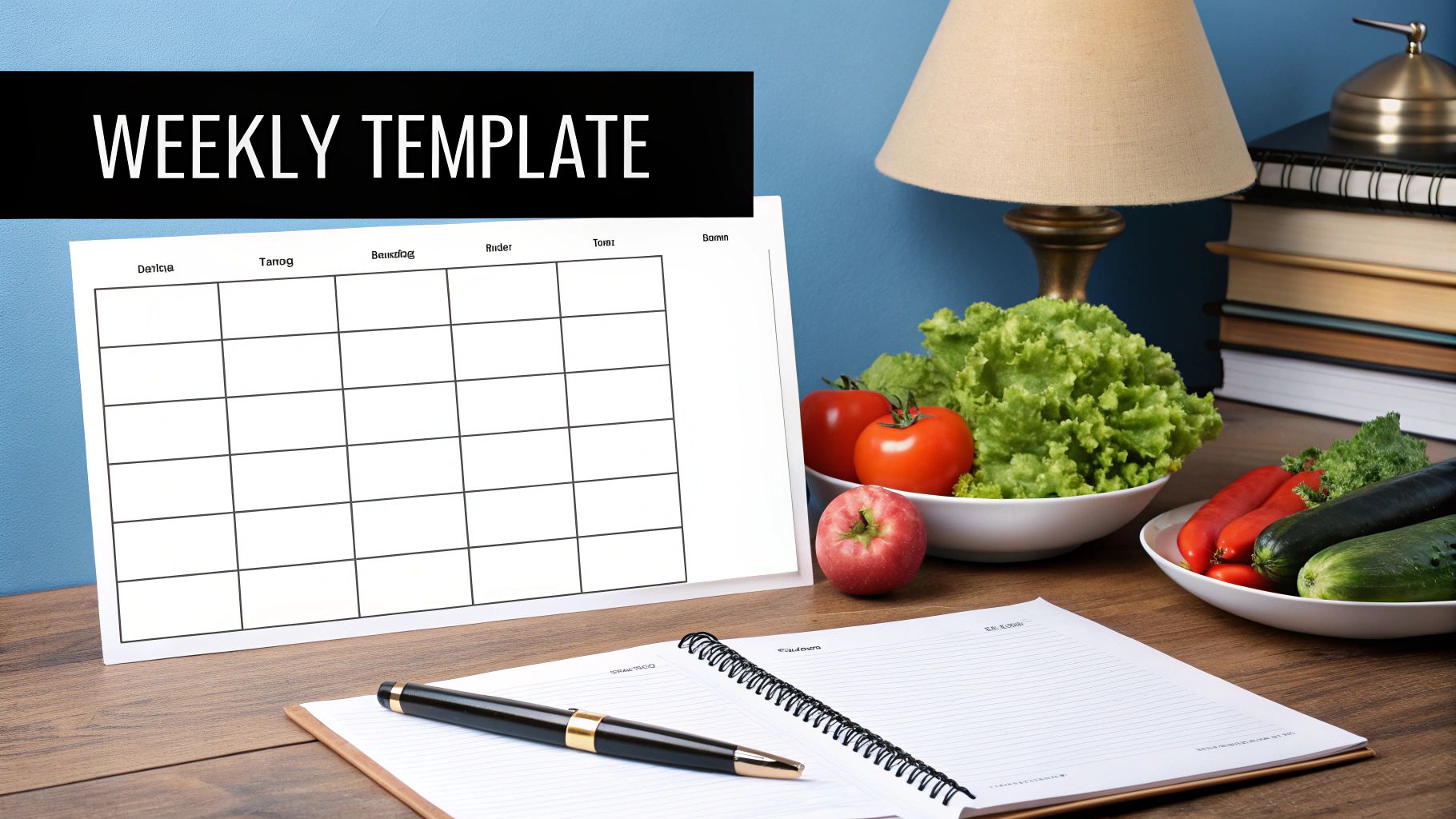
Okay, you’ve got your meal plan and grocery list. Honestly, that’s half the battle. Now for the part that really makes your week easier: the prep. This is your secret weapon against the 6 PM scramble, ensuring a healthy meal is always the path of least resistance.
Think of it like this: you're making a deal with your future self. You put in a couple of hours on a Sunday, and in exchange, you get back pockets of time and a whole lot less stress every single day of the week. This is how good intentions become solid habits.
Find Your Meal Prep Style
There's no one "right way" to do this. The best approach is whatever genuinely fits your life and how you like to eat. Some people want fully plated meals ready to grab from the fridge, while others just want the tedious chopping done so they can cook fresh.
Here are the most common ways people tackle it:
- Batch Cooking: This is my personal go-to. I'll make a huge pot of quinoa, grill a family pack of chicken breasts, and roast a massive sheet pan of veggies. During the week, I just mix and match these core components to build different meals.
- Ingredient Prep: Perfect if you love the act of cooking each night but hate the prep work. This is all about getting the annoying stuff out of the way—chopping the onions, dicing the peppers, marinating the protein. When it's time for dinner, you just grab and go.
- Assembled Meals: This is the ultimate grab-and-go method. Think salads layered in a jar, bento boxes with little compartments, or individual portions of a casserole. It’s a lifesaver for lunches.
Honestly, most people I know use a hybrid model. Maybe you fully assemble your lunches for the week but just batch-cook a protein and a grain for flexible dinners.
The Two-Hour Sunday Prep Session
The thought of a huge cooking session can be overwhelming, but you'd be shocked at what you can get done in just two hours. It’s all about working smart and multitasking. Here's a flow that works wonders for a weekly meal plan for healthy eating.
- Get the long-haul items going first. Crank up your oven and get grains like rice or quinoa simmering on the stove. These things cook themselves while you get on with everything else.
- Tackle all the produce at once. Wash, peel, and chop every vegetable you'll need for the week. Dice your onions, slice your bell peppers, and break down that head of broccoli. Pop them into airtight containers.
- Cook your proteins. While the veggies are roasting away in the oven, use the stovetop to grill chicken, brown some ground turkey, or hard-boil a dozen eggs.
- Assemble and store. Once everything has cooled down a bit, you can start portioning. Build your ready-to-eat lunches or just put your batch-cooked items into their own separate containers in the fridge.
Meal prep isn't about giving up your entire weekend. It’s a short, strategic burst of effort that pays you back all week long, making the healthy choice the easy choice when you're tired and hungry.
Getting Around Common Prep Problems
Even after years of doing this, I still run into hurdles. The two biggest culprits are usually food boredom and ingredients getting soggy or weird in the fridge after a few days. Luckily, the fixes are pretty simple.
To fight off flavor fatigue, think sauces, spices, and dressings. The same foundation of grilled chicken, brown rice, and roasted broccoli can taste completely different every day.
- Monday: Drizzle with teriyaki sauce and top with sesame seeds for an Asian-inspired bowl.
- Tuesday: Toss with a scoop of pesto and some cherry tomatoes for an Italian vibe.
- Wednesday: Mix in black beans, corn, and a cilantro-lime vinaigrette for a killer burrito bowl.
See? You keep your taste buds interested without having to cook three entirely separate meals.
As for keeping food fresh, it all comes down to storage. Good-quality, airtight glass containers are a worthy investment. Always let hot food cool before you seal the lid—this prevents condensation that leads to soggy food. And for salads, a pro tip is to always keep the dressing separate until you’re ready to eat. It makes all the difference in keeping those greens crisp.
Using Digital Tools for Effortless Meal Planning
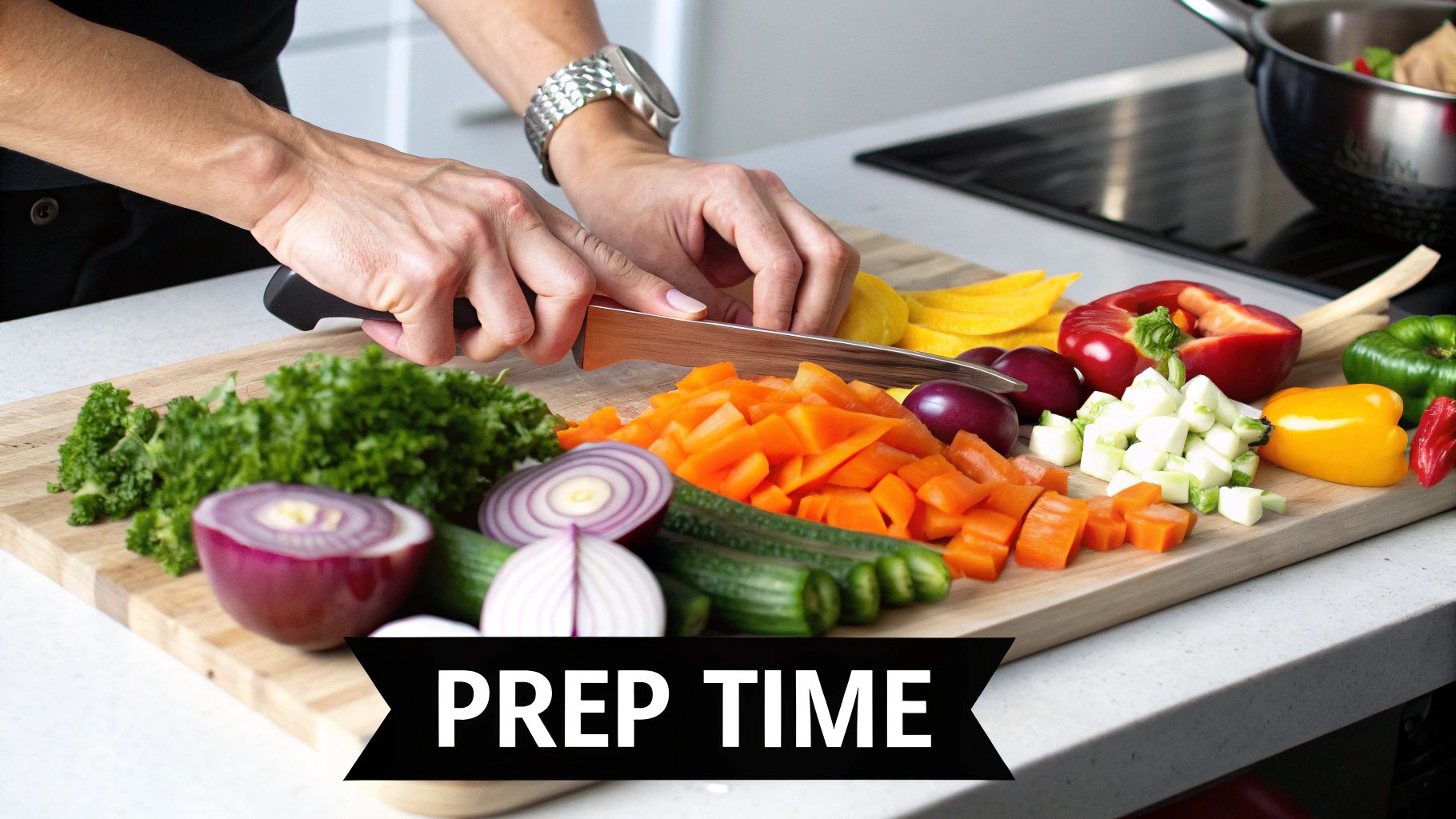
Let's be honest, trying to manage a meal plan with a patchwork of sticky notes, saved screenshots, and a clunky spreadsheet is a recipe for disaster. It turns a helpful routine into just another chore. Thankfully, we can ditch the chaos and lean on technology. Digital tools and apps are built to take that mental load off your plate, handling everything from finding new recipes to building your grocery list for you.
When you move your planning to an app, everything lives in one place. No more frantic searches for that chicken recipe you saw last week or realizing you forgot to write down milk. All the components of a successful weekly meal plan for healthy eating are right there on your phone, making the whole process feel less like work and more like a simple, streamlined part of your life.
Choosing the Right App for Your Goals
There are a ton of meal planning apps out there, but the "best" one is simply the one you'll actually stick with. Each app caters to a different need, so it’s worth taking a minute to think about what would genuinely make your life easier.
Look for features that line up with your specific lifestyle. Here are a few I find essential:
- Recipe Discovery: Can you find a good variety of meals that fit your diet? Even better, can you import your own favorites from websites you already love?
- Automatic Grocery Lists: This is a non-negotiable for me. The app should instantly turn your chosen meals into an organized shopping list.
- Customization: How easy is it to adjust for allergies, swap ingredients, or change the number of servings?
This isn’t just a niche trend. Projections show that by 2025, over 67% of adults aged 25 to 45 will be using digital planners or grocery apps multiple times a week. It points to a massive shift in how we manage our nutrition and our time.
Moving from a paper-based plan to a digital tool is like upgrading from a paper map to a GPS. Both can get you there, but one is faster, smarter, and adapts to your needs in real time.
Integrating Nutrition Tracking and Smart Features
The real power of these tools comes when they go beyond just basic planning. Many of the best apps now offer advanced features that give you a clear window into your eating habits, connecting your daily food choices directly to those health goals you set earlier.
For instance, integrated nutrition tracking is a game-changer. As you slot meals into your week, the app can automatically crunch the numbers, showing you the calories, protein, carbs, and fats for each day. It’s an easy, hands-off way to see if you’re hitting your targets without having to log every single ingredient manually. Finding the best nutrition tracking apps to pair with your planning can seriously streamline the whole process.
Some platforms take this a huge step further. Our own tool at https://ai-mealplan.com/ uses AI to build a plan for you, based entirely on your goals and preferences. It can generate a personalized weekly menu with balanced meals, proper portion sizes, and a full macronutrient breakdown. This kind of intelligent support eliminates decision fatigue and ensures every meal is truly working for you, not against you.
Common Meal Planning Questions Answered
Even if you’ve nailed down the best templates and Sunday prep sessions, questions still sneak in. Sticking to a weekly meal plan for healthy eating takes practice—and having quick fixes for hiccups makes all the difference.
This guide zeroes in on the real-world snags we all face, from last-minute shifts in our calendars to the monotony of eating the same thing day after day. Get these pieces dialed in, and your plan will feel more like a personal system than a laundry list of rules.
How Do I Meal Plan With An Unpredictable Schedule
When your week turns upside down at a moment’s notice, assigning “Pasta Monday” can feel pointless. Instead, build a lineup of five to seven go-to dinners. Each morning or afternoon, scan your calendar and pick whichever meal fits your time and energy.
On Sunday, try component prepping—roast, simmer or grill the core ingredients. Then assemble your meals in moments:
- A batch of shredded chicken or ground turkey
- A large container of a grain like quinoa or brown rice
- A tray of roasted mixed vegetables
With these building blocks in the fridge, you can whip up bowls, salads or wraps in minutes, no matter how unpredictable your day gets.
What Is The Best Way To Avoid Food Boredom
Relying on the same chicken-and-veggies combo every day is a quick route to burnout. To keep your taste buds interested, focus on small tweaks instead of overhauling the entire menu.
Introduce one new recipe each week, then play with sauces and spices so nothing feels stale.
Swap teriyaki glaze for one night, pesto for another, or dust that chicken with a simple taco seasoning blend. Little swaps deliver a big flavor payoff without extra work.
Finally, carve out a flex night—maybe a homemade pizza experiment or a quick takeout treat. That one break makes the routine feel more like your own plan instead of a prison sentence.
Can I Follow A Meal Plan On A Tight Budget
Absolutely. A weekly blueprint is your secret weapon against overspending. Start by checking store flyers and in-season produce lists. Next, choose wallet-friendly proteins:
- Beans and lentils
- Eggs
- Canned or frozen fish
Don’t forget to plan leftovers for lunch—it’s a straightforward way to cut waste and trim the grocery bill. And when impulse buys start calling your name, a precise shopping list is your best defense. If you want to automate this process, you can create a personalized account and pull budget-friendly plans in seconds.
How Should I Handle Snacks In A Healthy Eating Plan
Snacks should work for you, not against you. Treat them like mini-meals and plan two or three solid options each week. Aim for a mix of protein and fiber to bridge the gap between meals.
Here are a few of my go-to choices:
- Greek yogurt with berries
- An apple paired with a scoop of nut butter
- Baby carrots or bell pepper strips with hummus
- A small handful of nuts (almonds, walnuts)
Pre-portion these into grab-and-go containers on prep day. That way, when hunger hits, you’re reaching for something nourishing instead of whatever’s easiest.
Feeling ready to eat without the stress of planning? AI Meal Planner builds personalized menus, complete with grocery lists and straightforward recipes. Discover your perfect plan at https://ai-mealplan.com.
AI-powered nutrition
Get Your Personalized Meal Plan
AI creates the perfect meals for your goals, lifestyle, and taste.
Start Your Journej